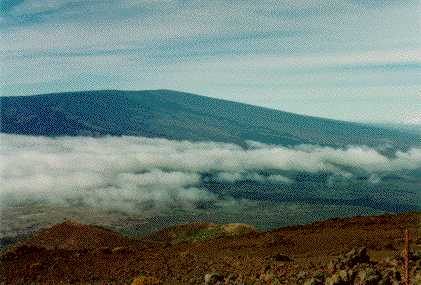
The Hawaiian island chain owes its existence to a stationary volcanic "hot spot" within the Earth's mantle. As the Pacific tectonic plate passes over, the latter is punctuated by newly formed material rising above the abyssal ocean plain. When this material rises above sea level a new island is born.
As such for the nature enthusiast Hawaii offers as its major attraction the opportunity to witness vulcanism in action on a large scale. The biggest island, Hawaii, is the most recent member in the chain, and lies at the eastern end of this, the fiftieth of the United States.
Roughly triangular with perhaps 90 miles to a side, Hawaii rises some 33,000 feet from the ocean floor to peak at Mauna Loa ("broad mountain" in Hawaiian), an active volcano, some 13,680 feet above sea level.

Most lofty is Mauna Kea ("white mountain") at 13,796 feet above sea level. Although Mauna Loa is far the broader and therefore more voluminous, Mauna Kea, being some 120 feet higher, claims the title of the world's tallest mountain if measured from its base.
Mauna Kea is famous for an array of world-class astronomical observatories situated immediately beneath the geographic summit. The combination of 320 cloudless nights each year, together with the altitude makes for a superb viewing platform into the heavens. In fact, at 14,000 feet, forty percent of the atmosphere and typically ninety percent of atmospheric moisture lie below the observer.
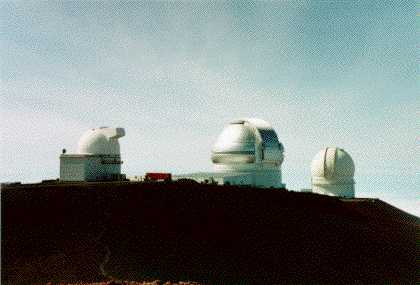
With these superlatives the two chief goals of the vacation were to climb Mauna Kea (without using the observatory access road!), and to explore Volcanoes National Park. Both of these goals are achievable with a visit to just the big island, i.e. without stopping in Honolulu, the cosmopolitan and pricey state capital, on the smaller island of Oahu.
The vacation began with a flight from San Diego to San Francisco on the morning of Saturday the eighteenth of April. The transfer to our Hawaii-bound jet was completed and we landed at Kona Airport, on the western dry side of the big island, just after eleven AM Hawaii time.
Edward and myself picked up our reserved car and drove to the nine thousand foot level of Mauna Kea. The following day we took our full backpacks and climbed to a camp we established around 13,100 feet just short of the summit. We reached the summit under very windy conditions that afternoon and descended to camp for the night.
The following morning, now Monday, we returned to our vehicle by ten AM and drove to Volcanoes National Park via the city of Hilo on the wet, Eastern side of the big Island. Before camping that night we observed the plumes of steam where the flowing lava pours into the ocean, and captured spectacular images of orange sky, by night, above the eruption site itself.
Tuesday and Wednesday were spent hiking within the Park. We drove when the distance separating sights of interest was larger than could be easily done on foot. The caldera of Kilauea volcano was the principal hike on Tuesday, while the eruption site, or, more specifically, the hike over volcanic terrain to the site, formed Wednesday's chief activity.
Thursday was a driving day with a counterclockwise tour of the East and North coastal areas of Hawaii. We stopped at waterfalls in a lush tropical setting; at Waipio Valley - an idyllic setting which Edward had read about as a child; and made camp in a deserted field by the roadside since no campgrounds were available without advanced reservations.
On Friday we returned to Kona by mid-morning for my flight back to the mainland and Edward's flight to Maui. He spent two additional days there to climb Haleakala, a ten thousand foot volcano, and to generally explore the scenery. He flew home Sunday night.
I arose around 4:30 in the morning and drove from my home in Del Mar Highlands the ten miles to Edward's apartment in Mira Mesa. From there we met our shuttle driver at five o'clock for the ride to Lindberg Field.
The flight to San Francisco departed on time and was uneventful. We transferred to the Hawaii-bound flight and, since there was nothing to see but water, found the flight unremarkable. However on descent into Kona we passed over the width of Hawaii and observed Mauna Loa and the northern and western coasts of that island.
The automobile was rented in my name. We paid an additional sum to enable Edward to legally drive as well, and drove some eight miles to the city of Kona. We passed by graffiti of white stones on a background of black lava rock, lying along the road for quite a stretch. I spotted a Hannukah menorah with its eight branches and central candle, rendered in stone.
On arrival in Kona we visited a shopping center to obtain fuel, purchase water, and generally search for edibles unique to Hawaii.
The camping fuel was not brought with us since, being a hazardous material, it is illegal to carry on board an aircraft. As such I had purchased in San Diego a stove capable of burning gasoline since that is widely available internationally whereas the liquified butane of my regular stove is not normally found. We purchased one gallon of fuel, as the smallest size available, even though only a fraction would be used on the trip.
I found all manner of confections based upon macadamia nuts, and at prices roughly one third for what little variety can be found in California. I purchased macadamia nut brittle, macadamia chocolates, and assorted oddities such as cuttlefish jerky which I had never seen previously.
Satisfied with our purchases we drove north and inland towards Mauna Kea. We passed homes with decorative walls of black lava replacing fencing. The walls lent a degree of character to the area which would be difficult to reproduce elsewhere.
After leaving the outskirts of Kona we eventually encountered a convoy of very slowly moving Army vehicles on a road with only one lane in each direction. It was too dangerous to overtake them and so I impatiently tagged along until they thankfully turned off.
I continued driving until we broke through the cloud layer at around 8,800 feet. A beautifully sunny day greeted us, now above the clouds, as we parked at the Hale Pohaku Astronomy Museum at nine thousand feet.
We spent most of the late afternoon enjoying exhibits of astronomical interest. I filled the donation box to compensate for the copious amounts of hot cocoa and coffee enjoyed with my macadamia treats.
Edward and myself simply walked across the road and made camp under the stars about 100 meters from the museum. That evening we participated in a free astronomical observing session with a 14-inch telescope. There were perhaps two dozen tourists who received their first views of several objects invisible to the unaided eye. More mocha. Much more.
It was marvelous to watch the heavens pass overhead as I fell asleep. Morning and evening of day one.
At nine thousand feet the degree of acclimatization afford by a night's sleep is considerably better than having starting out climbing directly from sea level. Nevertheless we planned upon reaching the summit of Mauna Kea, at 13,796 feet, that very afternoon. This would only be some 27 hours after having departed Kona at essentially sea level.
We commenced upslope around nine o'clock, heading in the general direction of the summit area. Progress was acceptable, given that we were carrying our backpacks, until around the eleven thousand foot contour. At that point Edward exhibited a lack of stamina, seeing as he desired to rest ever more often. The pace slowed further, until, around 12,500 feet, I too began to feel uncomfortably tired. He was carrying the tent, and in compensation I carried an extra gallon of drinking water.
We had outpaced ourselves in having set out with full packs so soon after having been at sea level. Furthermore Edward had not carbo loaded the previous day in preparation for the climb's large energy expenditure.
We continued, quite slowly, until gaining our planned camping area above thirteen thousand feet. We found partial shelter from the wind on the south side of a cave entrance. The tent was erected and we dove inside to sleep an hour. It was about 2 PM.
Upon arising I felt a slight headache which was relieved by water. Edward had carried a day pack while I emptied my main backpack except for snack and water. We headed for the summit, eventually obliging ourselves of the winding access road to the observatories immediately below the highest point. It was very windy, and, despite the image of Hawaii as warm, we wore our winter coats with gloves and ski masks.
We gained the true summit and spent only five or ten minutes owing to the wind. Edward took a few photographs of the distant horizon, although none of ourselves, and we sought shelter near a huge observatory dome a few minutes distant.
I munched on a cranberry-orange health bar while Edward explored the exterior of some observatories. Eventually it became cold enough, after one-half hour, for me to descend. Edward also descended, making a side trip to the Keck observatories prior to meeting me two-thirds of the distance back to camp.
I slept in the tent with a bad headache whenever I sat or stood up. It was sufficiently painful for Edward to have cooked my supper for me - a very kind gesture. I ate the cheesy mashed potatoes listlessly and shortly fell asleep. Morning and evening of day two.
Seven in the morning. Edward is outdoors peering at the pink and red hues of sunrise. I lay in my bag wary of sitting up. Eventually I drink 3 cups of water and have two little boxes of cereal with milk. I feel all better! What for but a little hydration.
We travel one half mile cross country to intersect the access road and follow it the remaining several miles to the museum where our auto awaits. It is ten AM and we had hoped to visit the museum again to compare our first hand experiences with the descriptions of observatories within. The museum being closed, Edward drove us down the road into the clouds.
The road east to Hilo is taken and we arrive mid-day. We have a difficult time locating a market yet eventually we find one to satisfy my habitual reward for a successful ascent - a pint of ice cream. This time it is Haagen Dasz "Macadamia Nut Brittle" since it perfectly matches both my mix-ins and the locale.
Edward drives us to Rainbow waterfalls as I finish the pint. More spectacular is the banyon, or fig tree, located nearby. It is huge and sends out roots, above ground, to join with its baby foliage roundabout. Edward takes several photographs with myself in one of them, so documenting the tree's large scale.

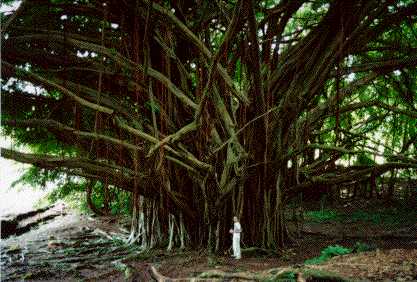
We travel south some thirty miles to the Volcanoes National Park visitors center. Inside an electronic sign notifies us that lava is flowing to the sea and can be viewed by driving the Chain of Craters road.
It is stated that to witness the plumes of steam billow up is nice by day and yet more enjoyable at night owing to the orange glow imparted. The road is blocked from the sight by four miles of lava flow and one can only approach closer, as a hiker, at one's own risk. We discuss the dangers with a Park ranger and then privately among ourselves. Prior to our arrival the tentative plan was to make the hike provided it was not too dangerous.
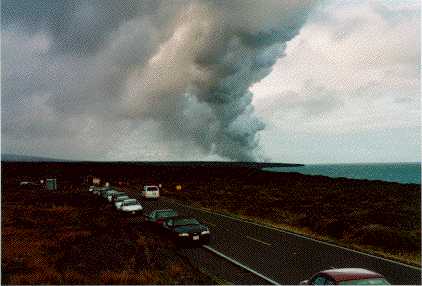
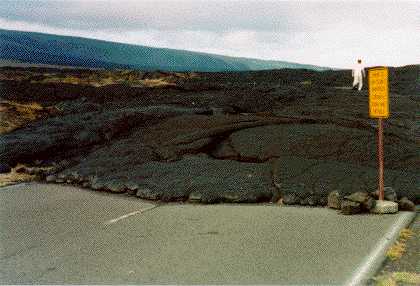
Given all the variables I suggest that we set up camp and immediately drive the 24 miles so as to witness the event during daylight. Then eat supper at road's end to wait for darkness. Finally observe at night and drive back.
Edward likes the plan and so it is done. Edward's eyes are slightly irritated by acidic fumes even at four miles and we cancel plans for a hike.
I enjoy raw ahi tuna and octopus in various sauces while Edward has macaroni and cheese for supper. I cannot leave Hawaii without sampling the bounty of their land and sea.
We remain after most tourists have left to take dark sky photographs of the orange glow above the actual eruption site. There are also specks of orange where the lava, flowing in tubes, becomes visible above ground, on its journey to the ocean.
We arrive at our camp, misplaced at just the wrong elevation to be permanently in cloud and mist at four thousand feet, and sleep by nine. Morning and evening of day three.
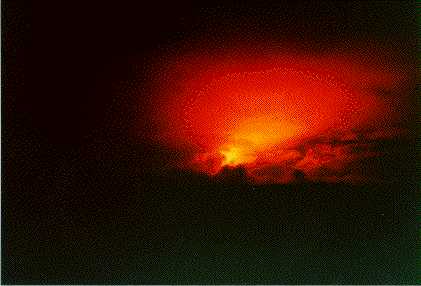
Kilauea is presently the most active volcano in the Hawaiian Islands, and possibly in the world. It has been erupting continuously for more than a decade, albeit with quiet streams of lava rather than a single violent and catastrophic event.
The current eruption site is several miles east of the caldera - a five mile diameter lava-filled pit surrounded by steep slopes and steaming in places at open vents. It is possible to hike onto the caldera by descending the slopes and this constituted a six mile hike in the morning.
When lava reaches the surface it cools and solidifies into one of two characteristic patterns. Pahoehoe forms when the lava is at a higher temperature and is ropy and smooth in both appearance and texture. A'a forms at lower temperature and is extremely jagged. It is quite difficult to walk upon and can tear apart normal footwear.
The caldera is nearly all pahoehoe and so is not difficult to walk over. Strange, other-wordly formations exist which would be very difficult to either imagine or describe but for actually having been there.
Lava tubes, now hollow, crisscross the view, and tiny plants gain a foothold within the cracks between sheets of lava rock. A smattering of rock outcroppings punctuate the horizon, each with its unique signature of wierd and bizarre geometries.
We spend much of the afternoon on a clockwise driving loop that circumnavigates the caldera. Many Japanese tourists are spotted, their tour busses stopped at any of a dozen vistas.
At one vista a short walk brings one to yellow sulfur formations inside a crater buried in the caldera's west side. Hot vapors exit at ground level all about you. I decided to experiment, successfully cooking a few pieces of raw tuna by impaling them on a fork and thrusting it into an exit porthole in the hot rock. Although rotten egg odor of sulfur dioxide pervaded the air, the flesh was cooked (albeit rare) and was tasty. I was about to toast one of Edward's brown sugar and cinnamon Pop Tarts when he returned from the crater walk.
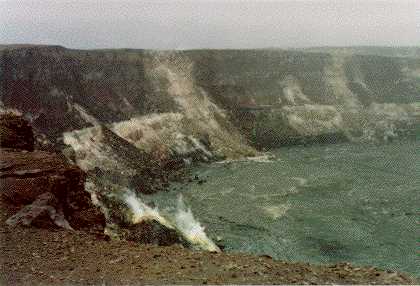
That evening with nothing to do in camp we sit in the lobby of the Volcano House hotel across the street from the visitors center. I read a wonderful National Geographic magazine brought for the spare moment, and purchase various souvenirs, mainly food, mailed to my home in California.
We visited the Thurston Lava Tube - large enough for one to walk through.
We also visited the Hawaii Volcano Observatory. This is a combination research outpost and museum located just north of the caldera. It features educational displays on vulcanism and reveals the history of scientific investigations in the area.
Again to sleep in the mist inside an increasingly dirty tent. Morning and evening of day four.
The following morning, now Wednesday, we embark on a fourteen mile hike to the eruption site. In truth one is not allowed closer than perhaps 2 or 3 miles. As such it resulted that the main attraction of the hike was the hike itself.
On the hike one traverses the wierdest and most contorted landscape I have yet encountered. The earth is black lava rock, only a few decades old, with remarkable geometries on many scales resulting from the viscous nature of the lava when it once flowed. Lava tubes are visible round about.
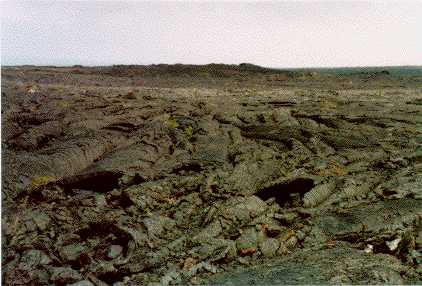
Some of the rock is brittle to the touch. In places a lone tree forces lava to flow around it. Upon solidification there results a break in the otherwise smooth surface just where the tree is located. Sometimes a circular or radial pattern arises, with striations like a set of wheel spokes crystallized for all to view in admiration.
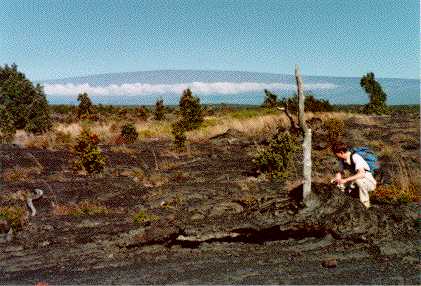
One point of contention during the vacation was the propensity for Edward to go on what to me appeared to be every minor hike and stroll available. For my sake the essentiality of the trip had been accomplished - climbing Mauna Kea and observing the natural wonders available in the Park. It got to the point that by now I would just as soon nap five minutes in the driver's seat rather than visit the upteenth lookout. When asked by Edward if I had any better ideas I replied that for me the only other item of interest was the local food, and THAT was not of interest to HIM.
At 4 PM we had a couple hours of daylight. So we drove west fifty miles, then south twelve, and found ourselves at the southern tip of Hawaii. It is here that a green sand beach exists, as formed by the high olivine content of the metamorphic rock after it is weathered by erosion.
Unfortunately we did not have sufficient information to efficiently located this beach, and, with our best hunch being that it was three miles on foot one way, we would arrive by dark and thus be unable to verify the green color on inspection. So I fell asleep while Edward walked perhaps a hundred yards, scooped up some green sand, and returned it, in hand, to me. I was elated and stored it in the emptied and cleaned pint ice cream container. Vindication for the long drive. And so thoughtful of Edward. I drove back to camp. Supper. Wet and disgusting tent. Morning and evening of day five.
Although G-d may have rested on the seventh day, I decided to REALLY rest, as a "vacation within a vacation", on day six.
In fact we broke camp and, with Edward driving the entire day, performed a counterclockwise circuit up the east coast of the island, whence west along the north coast by evening.
The first stop was in Hilo where I stocked up on more fresh fish plus assorted sweets and condiments. Not to forget another pint of ice cream to savor with pumpkin-sesame candy and other local goodies.
We stopped at a local waterfall which proved uninspiring, followed by a drive with foliage, overlapped overhead from left and right, forming a living green tunnel as we passed under.
We continued to Akaka falls - a very lush and wet place with two separate falls, each plunging hundreds of feet and forming their own local mist. The foliage reminds one of all that is envisioned as paradise, perhaps even the Garden of Eden.
Yet for all its tropical lure I certainly prefer the austere and relatively lifeless scape of a high mountain.
It was two o'clock when we spied Waipio Valley from road's end nine hundred feet above. From there an extremely steep road with a 25% grade led into the valley. Drivers are warned of the danger without emergency brakes.
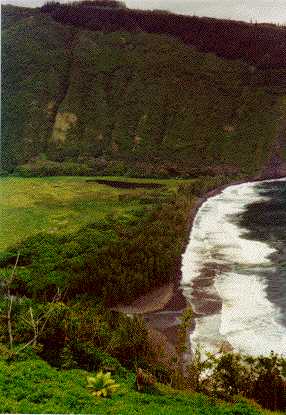
After a few pictures I elected to befriend the ice cream truck vendor. With a bottle of kosher for Passover zinfandel wine (part of a gift package sent by my parents to my home the previous month), I became somewhat inebriated on crazy combinations of chocolate malted ice cream and wine. With Passover macaroons.
Edward, of course, hiked into the valley. He returned two hours later with tales of beautiful scenery. I suppose, as I noted at the time, that he had his fun and I had mine.
Unable to find a vacant campsite nearby we drove until seven PM in the direction of the west coast, the aim being to approach our point of departure the following day. We arrived at an empty dirt lot with abandoned cars by the roadside. The evening was made enjoyable by an astronomy lesson, Edward as instructor, simply lying on our sleeping bags and pointing out the stars situated overhead.
I had accomplished my goal of virtually no physical activity. Morning and evening of day six.
The following morning we were very close to Kona and yet had nothing much to do. Thereby we drove in the opposite direction to the birthplace of King Kamehameha, the warrior chief who two hundred years ago united all of the Hawaiian Islands under one rule. A bronze statue commemorates this leader.
On entering Kona Edward ate breakfast at Denny's while I shopped for exotic foods at the supermarket. Again we each had it our way - I will not have standard food so as to miss part of the culture. I admit, however, that I sometimes take this to an extreme.
We repacked our gear in the parking lot of a small shopping center, emptying our fuel bottles so as to enable their safe transport aboard aircraft. I purchased a bottle of pineapple wine.
On return to the airport we paused for a photograph of me sitting next to the menorah of white rock. The car was handed back followed by the customary farewell words to one another. My flight departed about one PM for San Francisco and ultimately home. Edward continued his vacation with a short inter-island hop to Maui.
Hawaii owes its very existence to the fires deep within the Earth. The volcanic rock, once broken down, forms excellent soil which provides essential nutrients for the dense plant life. As such it was appropriate to have focused on the geological aspects of the island.
To enjoy the sun, white sandy beaches and fancy hotels of Honolulu, as most fanciers of a Hawaiian vacation imagine, would have done injustice to this fiftieth of United States. Such a vacation makes a mockery of the true face of Hawaii - born in fire, drenched in tropical moisture, and destined to remain, at least in the forseeable future, the only place where new real estate appears out of nowhere.